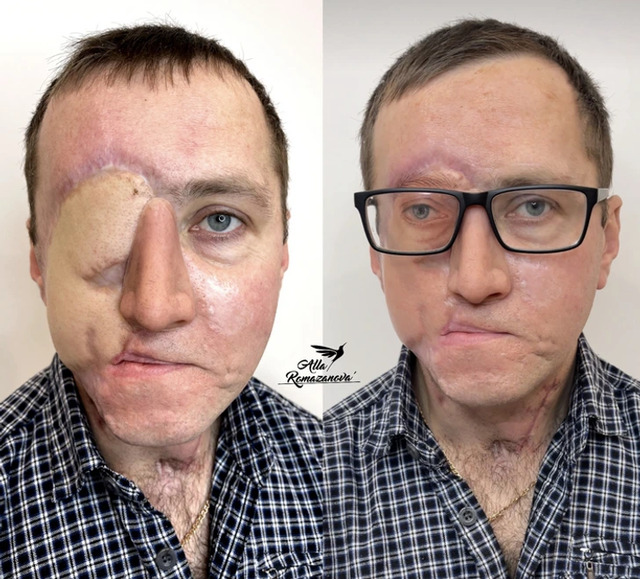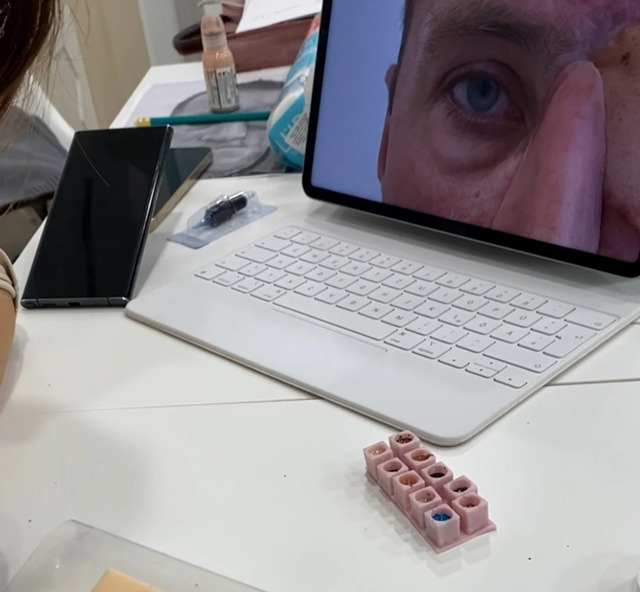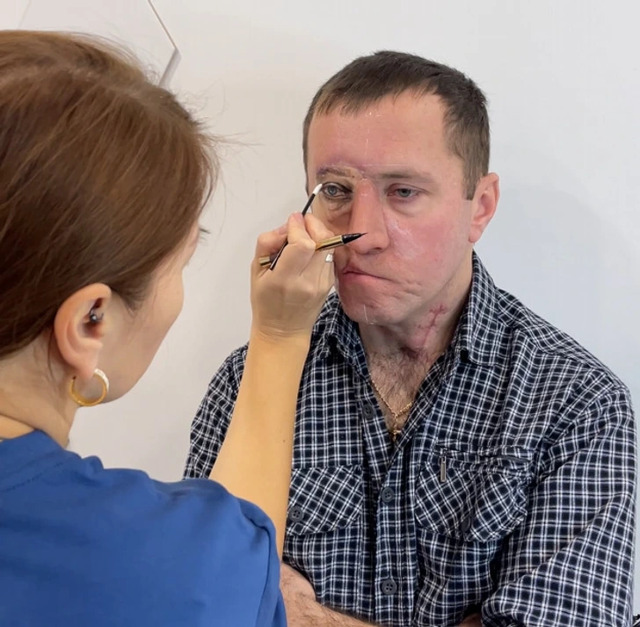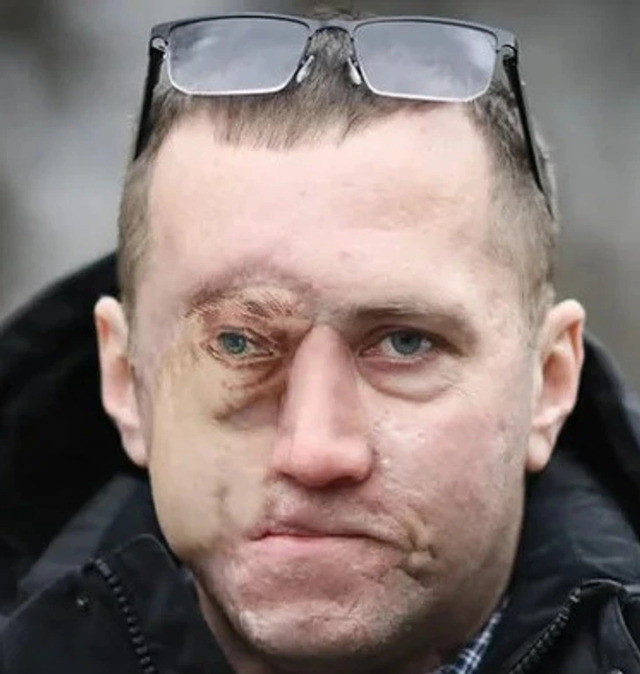How a Hyper-Realistic Eye Tattoo Helped a Car Crash Survivor Reclaim His Life and Confidence
When a young man walks into a tattoo artist’s studio, hoping to restore more than just his appearance, the result can be life-changing. For one car crash survivor, this journey led to the creation of a hyper-realistic tattoo that would help him reclaim his identity and confidence. After a devastating accident left him disfigured, Pavel faced the challenge of losing not only his physical appearance but his sense of self. However, thanks to the extraordinary work of a skilled tattoo artist, he found a way to transform his trauma into something empowering. This is the story of how an artist’s incredible ability turned pain into art, giving Pavel a chance to rediscover who he was.
The Accident: A Tragic Transformation
Pavel’s life was altered forever after a life-altering car crash that left him with serious injuries, including the destruction of his nose and the loss of an eye. What seemed like a bright future in an instant vanished, and Pavel had to face the harsh reality of his disfigurement. Doctors initially suggested growing a new nose from his arm and then grafting it onto his face, but given his diabetes, each operation carried significant risks. His situation became more complex as doctors recommended removing his damaged eye to avoid jeopardizing his healthy one.

Faced with these painful decisions, Pavel made the difficult choice to embrace the long recovery process. He underwent skin grafts to repair the right side of his face, which took nearly a year to heal. Meanwhile, doctors called in sculptors to recreate his nose using old photographs to ensure the final result closely resembled his original appearance. Despite the surgeries and uncertainty, Pavel remained hopeful, but one major challenge remained: what to do about the eye he had lost forever.
Video
See how a hyper-realistic eye tattoo turned trauma into strength—watch now!
Choosing Art Over Prosthetics: The Bold Decision
Initially, Pavel was faced with the decision to either go for a standard glass prosthetic eye or explore a more unconventional path. A prosthetic seemed like the practical solution, but it never felt like it would restore the identity he had lost. It was then that doctors introduced him to a tattoo artist renowned for her hyper-realistic work, known for helping clients with scar coverage, alopecia-related eyebrows, and even breast cancer survivors. But this was different—it was not just about covering up or enhancing; it was about recreating a part of Pavel’s identity he thought he had lost forever.

The idea of using a tattoo to replicate his eye was both unconventional and daring, yet it was this path that ultimately felt right for Pavel. Rather than relying on a lifeless prosthetic, he could choose a solution that would merge art and healing in a way that gave him back not just a look, but a sense of wholeness. This decision marked the beginning of an extraordinary artistic journey.
The Tattoo Artist’s Challenge: Crafting a New Eye
Creating a hyper-realistic eye tattoo is a challenge in itself, but it was the combination of Pavel’s healing skin and his scar tissue that made the task even more complex. The tattoo artist had to navigate the unpredictability of tattooing on skin that had been grafted and altered. This was no typical project; it required months of study, practice, and collaboration with Pavel’s medical team.
The artist spent countless hours researching and understanding Pavel’s previous appearance. She studied old photographs of him to replicate the exact color, shape, and texture of his original eye. This wasn’t a process of simply sketching an image—it was about creating a work of art that would seamlessly integrate into his facial features. The artist also developed a custom ink palette because the sclera (the white part of the eye) isn’t pure white and needed to be matched precisely to achieve a natural look.
But the biggest challenge wasn’t just creating a realistic image; it was ensuring that the tattoo would appear as though the eye was a natural part of his face. The artist had to focus on replicating depth on a flat surface, giving the illusion of receding into the skin. It was a delicate balancing act that required both technical expertise and artistic vision.
The Tattoo Process: Bringing Pavel’s Eye to Life

After months of preparation, the day arrived when the tattoo artist was ready to begin the process. The first step was to mark the exact position of the eye, ensuring that it aligned perfectly with Pavel’s face. The artist worked carefully, taking into account his unique skin texture and the changes caused by the previous surgeries.
Hours passed as the basic outlines of the eye began to emerge. When Pavel first looked in the mirror, his reaction was priceless. “Wow! It actually looks like something!” he said, his smile a clear sign that the tattoo had already surpassed his expectations. It wasn’t finished, but the basic design had brought a level of realism that neither he nor the artist anticipated so soon.
The artist worked tirelessly, adding shadows, glints of light, and fine details to ensure the tattoo would appear lifelike. As the process continued, it became clear that Pavel’s vision had come to life in the form of art—a tattoo that would not only restore his appearance but also help him regain confidence in his identity.
Realistic Tattoos in Medical Recovery: A Growing Trend
Hyper-realistic tattoos, once primarily a form of self-expression, are now playing a significant role in medical recovery. These tattoos are helping people who have suffered from burns, surgeries, and other physical trauma to restore a sense of self. Pavel’s experience is just one example of how art can be used for healing, allowing individuals to reclaim their bodies and their identities.
From scar-covering tattoos that give burn survivors a renewed sense of comfort to eyebrow tattoos that restore dignity for those with hair loss, realistic tattoos are proving to be more than just ink on skin. They are transformative tools for rebuilding self-esteem, giving people the chance to feel whole again. In Pavel’s case, the hyper-realistic eye tattoo allowed him to reclaim a vital part of his identity, helping him feel like himself again after enduring so much physical and emotional trauma.

Empowerment Through Art: The Healing Power of Tattoos
Pavel’s journey from disfigurement to recovery through art is a powerful testament to the healing potential of tattoos. Beyond the physical restoration, tattoos have the ability to shift a person’s story from one of trauma to empowerment. By choosing this artistic path, Pavel took control of his recovery, deciding that he would not just endure the scars of his past, but transform them into something meaningful.
Medical tattoos like the one Pavel received offer more than aesthetic benefits—they help individuals take back ownership of their bodies and, in many cases, reclaim their lives. For Pavel, this tattoo was not just a form of restoration, but an empowering symbol of resilience and strength. Tattoos, in this context, become more than just art; they are healing tools that enable people to move forward and rediscover their sense of self.
Video
Curious how deep a tattoo really goes into your skin? 
Conclusion: Art as a Tool for Healing and Empowerment
Pavel’s story demonstrates how tattoos are redefining the boundaries of both art and healing. From the medical challenges he faced to the artistic brilliance of the tattoo artist, his journey is one of remarkable transformation. What began as an idea to restore his appearance through a prosthetic eye turned into an empowering process that helped him reclaim his sense of self and move beyond the trauma he had suffered.
Tattoos, particularly hyper-realistic ones, are proving to be powerful tools in the medical world, helping people who have faced immense physical and emotional challenges to feel complete again. Pavel’s experience underscores the profound impact art can have on the human spirit, turning pain into empowerment and showing that sometimes, healing comes in the form of creativity.

